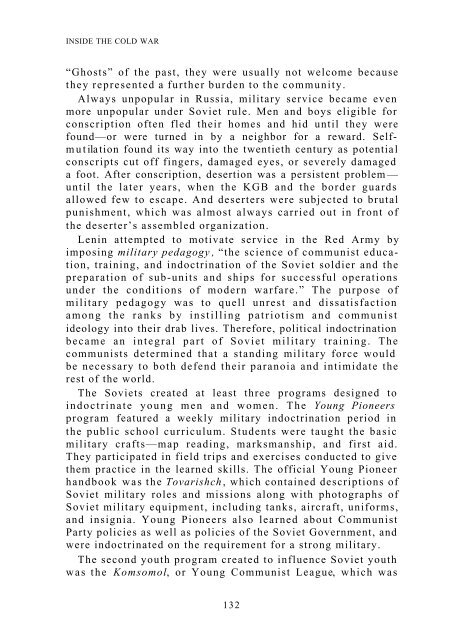You also want an ePaper? Increase the reach of your titles
YUMPU automatically turns print PDFs into web optimized ePapers that Google loves.
INSIDE THE COLD WAR<br />
“Ghosts” of <strong>the</strong> past, <strong>the</strong>y were usually not welcome because<br />
<strong>the</strong>y represented a fur<strong>the</strong>r burden to <strong>the</strong> community.<br />
Always unpopular in Russia, military service became even<br />
more unpopular under Soviet rule. Men and boys eligible for<br />
conscription often fled <strong>the</strong>ir homes and hid until <strong>the</strong>y were<br />
found—or were turned in by a neighbor for a reward. Selfmutila<br />
tion found its way into <strong>the</strong> twentieth century as potential<br />
conscripts cut off fingers, damaged eyes, or severely damaged<br />
a foot. After conscription, desertion was a persistent problem—<br />
until <strong>the</strong> later years, when <strong>the</strong> KGB and <strong>the</strong> border guards<br />
allowed few to escape. And deserters were subjected to brutal<br />
punishment, which was almost always carried out in front of<br />
<strong>the</strong> deserter’s assembled organization.<br />
Lenin attempted to motivate service in <strong>the</strong> Red Army by<br />
imposing military pedagogy , “<strong>the</strong> science of communist education,<br />
training, and indoctrination of <strong>the</strong> Soviet soldier and <strong>the</strong><br />
preparation of sub-units and ships for successful operations<br />
under <strong>the</strong> conditions of modern warfare.” The purpose of<br />
military pedagogy was to quell unrest and dissatisfaction<br />
among <strong>the</strong> ranks by instilling patriotism and communist<br />
ideology into <strong>the</strong>ir drab lives. Therefore, political indoctrination<br />
became an integral part of Soviet military training. The<br />
communists determined that a standing military force would<br />
be necessary to both defend <strong>the</strong>ir paranoia and intimidate <strong>the</strong><br />
rest of <strong>the</strong> world.<br />
The Soviets created at least three programs designed to<br />
indoctrinate young men and women. The Young Pioneers<br />
program featured a weekly military indoctrination period in<br />
<strong>the</strong> public school curriculum. Students were taught <strong>the</strong> basic<br />
military crafts—map reading, marksmanship, and first aid.<br />
They participated in field trips and exercises conducted to give<br />
<strong>the</strong>m practice in <strong>the</strong> learned skills. The official Young Pioneer<br />
handbook was <strong>the</strong> Tovarishch, which contained descriptions of<br />
Soviet military roles and missions along with photographs of<br />
Soviet military equipment, including tanks, aircraft, uniforms,<br />
and insignia. Young Pioneers also learned about Communist<br />
Party policies as well as policies of <strong>the</strong> Soviet Government, and<br />
were indoctrinated on <strong>the</strong> requirement for a strong military.<br />
The second youth program created to influence Soviet youth<br />
was <strong>the</strong> Komsomol, or Young Communist League, which was<br />
132
















